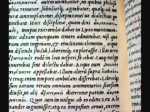Ever wonder where Italic type came from? I didn’t. Until I was doing some research on punctuation and there was a picture of Aldus Manutius, an Italian printer and inventor of the semicolon, italic typeface, and the father of modern punctuation according to The Guide to Grammar and Writing. Manutius lived from 1449 to 1515.
Manutius was educated in Latin and Greek. He was friends with famed Italian philosopher, Giovanni Pico, who gave him the money to start a printing press.
Italic writing was based on calligraphy, and there are different styles. “Italic type was first used by Aldus Manutius and the Aldine Press in 1501, in an edition of Virgil dedicated to Italy,” according to Wikipedia. Anything typed on an old typewriter that was a title was underlined. With Manutius’s invention, it was italicized when professionally printed.
Manutius was also one of the first, or maybe the first, to print small books that could easily fit into men’s pockets, and so the “pocket book” was born. Also, according to Wikipedia, In 1501 “Aldus [Manutius] wrote to his friend Scipio: “We have printed, and are now publishing, the Satires of Juvenal and Persius in a very small format, so that they may more conveniently be held in the hand and learned by heart (not to speak of being read) by everyone.” The Satires were written in 1st and 2nd AD. I can’t imagine memorizing them or what that might do to one’s attitude! Here is a small sample found in Sat I:19-44:
It’s hard not to write satire! For who’s so tolerant of Rome’s
Iniquities, so made of steel they can contain themselves
When along comes that lawyer Matho’s brand new litter,
Full of himself; behind, one who informed on a powerful
Friend, ready to steal any scraps from the noble carcase,
In 1501, Manutius began printing small books known as an octavo, and soon his name was associated with that term. An octavo’s size depends on the size of the sheet it is printed. To print pages for an octavo, which means one-eighth, 16 pages of text are printed on one sheet which is then folded three times to produce eight leaves. So the size of the book will be one-eighth the size of the sheet.
“A sixteenth century octavo printed in France or Italy is about the size of a modern cheap paperback, whereas an eighteenth-century octavo printed in England is larger, about the size of a modern hardcover novel,” saysWikipedia. “The oldest surviving octavo book apparently is the so-called “Turkish calendar” for 1455, presumably printed in late 1454, about the same time as the Gutenberg Bible.”
Manutius was also the first to print a semicolon in 1494. There are many uses for the semicolon, and different meanings for it in different languages. Many authors have advised against using it. Kurt Vonnegut in A Man Without a Country (2005) stated: “Here is a lesson in creative writing. First rule: Do not use semicolons. They are transvestite hermaphrodites representing absolutely nothing. All they do is show you’ve been to college.”
I’m not sure I will take that advice; I believe the semicolon is here to stay!
http://www.nevabodin.net, NevaBodin1@Twitter, Facebook


Very interesting post Neva, and full of information I did not know. I enjoy learning about the history of things. i had never heard of Aldus Manutius and his invention of italic writing and the semi-colon. Also, it was new to me that small “pocket books” or paperbacks as they are called today were printed so early. Thanks for sharing this bit of history with us. Love Kurt Vonnegut’s comment but I’m sure most writers brushed it off. Everyone to their own opinion. As for me, I will continue to use the semi-colon!
LikeLike
thanks Linda. I am slow to reply as my husband had open heart surgery the day before this post came out and I am sitting in the hospital room yet. Am not always able to connect in this hospital to the web. I really appreciate your comments. This was not really a planned post but I too like finding out little known facts about things.
LikeLike
I’ve been to college and like the flexibility the semi-colon provides for nonfiction and fiction writing. I came. I saw, I will include a semi-colon; take that Kurt Vonnegut. Thanks for the fun post, Neva. Mike Staton
LikeLike
Thanks Mike, I appreciate the reading and comment. I have to watch myself sometimes that I don’t over use the semi-colon. It’s quite obvious many don’t agree with Vonnegut. Anyway, this was trivia that just happened on the way to an article. I enjoyed doing it and hoped fellow writers could relate. My husband had major surgery the day before this posted so am late in replying.
LikeLike
Neva, great post. Very informational. As writers, we should know these little tidbits about the tools we use to write and where they originated. I’m ashamed to say I have never heard of an octavo. Now I know what it is and where the term came from. Thanks so much.
LikeLike
You are welcome Sherry. I hadn’t either, and this blog became a rabbit trail on the way to write an article for our newspaper. Had not wondered when these things started before and then felt I should have! Thanks for reading.
LikeLike
Very interesting, Neva. I didn’t know about the origins of italics, octavos, or pocket books. I too find semicolons useful sometimes–though more so in academic than creative writing probably.
LikeLike
It’s interesting that Vonnegut didn’t like them. Would imagine it had to do with the tempo or rhythm of his stories, but of course that’s conjecture. I think too they are not as useful in fiction, but sometimes “fit the bill.” Thanks for reading. Sorry for the late response but have been with husband who had major surgery day before my post published.
LikeLike
I’m very much in favour of using colons and semicolons. though the usage has changed over the years. What I was taught in the 1960s doesn’t find house room nowadays- but it doesn’t stop me using them. I hadn’t heard of Aldus Manutious so this was very enlightening; octavo, quarto and other folds I had heard of. 😉
LikeLike
Thanks for reading Nancy. I had never intended to find out about Aldus but it happened on the way to an article I was writing. As I read further, I thought some other writers might find this trivia interesting too. It’s funny how writing rules have changed along with styles and more’s isn’t it? Sorry for the late reply but have spent most of time in hospital past six days with my husband who had surgery.
LikeLike
I never thought to wonder where italics and semicolons come from. Thanks for an interesting post.
LikeLike
You’re welcome Abbie. It was a fun article to write and just happened while doing research on italics.
LikeLike
Neva, thanks for the printing information. Did you see the comment on my facebook page from Tim? Interesting too. Thanks Cher’ley
LikeLike
Unfortunately I haven’t been able to be on Facebook except a short while last night. My husband had open heart surgery last Friday, day before this post came out and I can’t always connect to the net at the hospital where I have been essentially living. Not sure when we will go home, but soon I hope. This post happened on the way to looking up use of italics for an article and I found it interesting so dug further and ended up with a blog that I hoped might be interesting to other writers.
LikeLike
Neca, this was such a fun and informative read. Thank you for digging up the facts and letting the rest of us in on the story.
As for the semi colon; well, let’s just say it has a place…we just need to decide where. Doris
LikeLike
Love your observation, Doris. I sometimes find too many places and have to delete it to make my sentences stronger. But it definitely has a place I think too. Have been sitting in the hospital with my husband who had major surgery day before this published so am late in replying. I thank you for your comment.
LikeLike
Fun post Neva. I’d heard of octavos but didn’t really know what they looked like. Interesting how they were made. I hadn’t realized pocket books started so early.
I tend to agree with Kurt V. Don’t see much use for semicolons, at least in fiction.
LikeLike
I think you are right about not as much use as in non-fiction or perhaps journalism or essays. I learned a lot researching use of italics and thought I ‘d share it. Been in the hospital beside my husband who had majory surgery May 2 so am late in responding, but appreciate your comments very much.
LikeLike
The semicolon is my favorite punctuation mark. I hated to have to stop using it when I began writing fiction. It never occurred to me that anyone invented it, though. It’s a strange feeling to realize I’d never even thought about it–as if punctuation were natural phenomena, like rocks and trees. Your post has opened a new area of research for me. Thanks.
LikeLike
I love semi-colons also and use them a lot; and yes, I’ve been to college, so there, Mr. Kurt! Intriguing post, Neva — didn’t know most of this information, so thanks for the research and sharing!
LikeLike